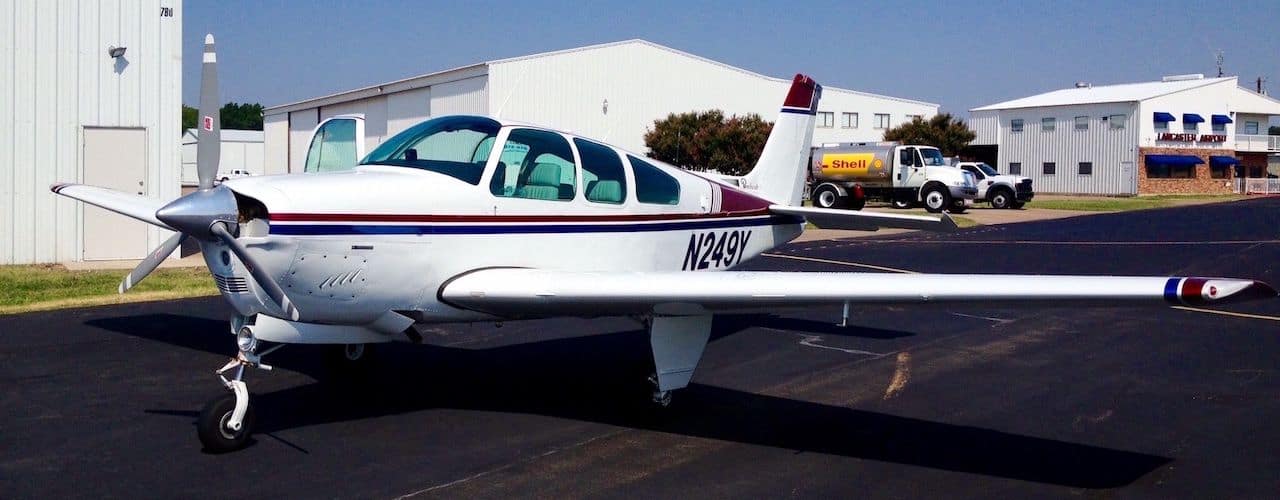
Beech Bonanza E33A E33C
The Beech Bonanza E33A E33C were manufactured from 1968 until 1969, serial number CE180 through CE289. It is a single-engine, piston aircraft configured as a cantilever low-wing aircraft with a conventional tail. Distinguishing features are: retractable landing gear, constant-speed propeller. Models E33A E33C Bonanza seats up to 3 passengers and 1 pilot.
Specifications
Exterior Dimensions
Wing span: 32 ft 10 in
Length: 26 ft 8 in
Height: 8 ft 3 in
Interior Dimensions
Cabin Height: 4 ft 2 In
Cabin Width: 3 ft 6 in
Cabin Length: 6 ft 1 in
Baggage door: 3 ft x 3 ft 1 in
Weights
Max TO weight: 3,300 lb
Empty Weight: 1,915 lbs
Maximum Payload: 1,385 *varies widely by individual aircraft
Fuel capacity: 50 gal
Engine
Manufacturer: Continental Motors
Model: IO-520-B
Horsepower: 285 hp
Overhaul (HT): 1700hr TBO
Standard Avionics
Digital Nav/Coms
2-axis autopilot
GS/DME/ADF
ADS-B In/Out
Performance
| Horsepower: 285.00 | Gross Weight: 3,300 |
| Top Speed: 181 | Empty Weight: 1,915 |
| Cruise Speed: 174 | Fuel Capacity: 50 |
| Stall Speed (dirty): 53 | Range: 520 |
| Rate of Climb: 1,200 | Rate of Climb (One Engine): |
| Service Ceiling: 18,300 | Ceiling (One Engine): |
| Takeoff | Landing |
| Ground Roll: 880 | Ground Roll 632 |
| Takeoff Roll Over 50 ft: 1,225 | Landing Roll Over 50 ft: 1,150 |
History
The Model 33 Debonair flew for the first time in September 1959. It was basically similar to the Model 35 Bonanza, but had a conventional tail assembly in place of the “V”-type tail. The Debonair was produced in four-seat versions with a 225-hp Continental IO-470-J, six cylinder engine. It had a simplified interior and less elaborate equipment than the Model 35. In 1961, the aileron and elevator trim tabs were improved, and larger rear windows and a restyled cabin interior with bucket seats were featured. In 1966, the option of a 285hp powerplant was added.
The Debonair name was dropped in 1967 and the subsequent aircraft, now a part of the Bonanza family, were simply designated E33, F33 and G33. During these years all model numbers ending in “A” featured the 285- hp Continental. All others retained the 225-hp engine. In 1972, the G33 was introduced with a 260-hp Continental.
Variations
Beech E33A Bonanza (1968) serial numbers CE-180 through CE-289
The E33A is an E33 with a 285 hp Continental IO-520-B engine. The following serial number E33As were removed from civilian production and converted to U.S. Air Force Pave Eagle I aircraft: CE-218 CE-219 CE-221 CE-222 CE-223 CE-224 The E33A Bonanza seats up to 4 passengers plus 1 pilot. There were 85 built.
Beech E33B Bonanza
Aerobatic versions of the E33 and E33A, the Model E33B and E33C were very similar except for customer choice of engines. The E33B had 225 hp, the E33C had 285 hp and became the preferred type; no E33B were produced.
Beech E33C Bonanza (1968-1969) serial numbers CJ-1 through CJ-25 (formerly E33A sn's CE-236 through CE-269)
E33B with a 285 hp Continental IO-520-B engine, Both models were licensed in the acrobatic category at gross weight or could operate at their full 3,300-pound maximum gross weight in the utility category. Major differences between the -C and the -A are a strengthened tail, positive-pressure fuel pump and a cabin door that can be jettisoned. During aerobatic flight, only the two front seats were occupied and a quick release door was standard equipment, along with front seat shoulder harnesses, a g-meter and special fuel boost pump and unique checkerboard paint on wing and tail tips. Typical aerobatic maneuvers approved were aileron roll, barrel roll, inside loop, Immelman, Cuban eight and split-S. The E33C Bonanza seats up to 3 passengers plus 1 pilot. 25 Model E33C were built.
Beech F33A Bonanza (1970-1994) serial numbers CE-290 through CE-1791
The F33 sibling with a 285 hp Continental IO-520-B engine and continued production until 1994. The F33A was produced in two versions with no model designations to differentiate them. The 1970 version was your short cabin version of the straight-tail Bonanza with a big motor and 26 of these were built. The 1971 version got the long cabin of the contemporary Bonanza which moved the aft bulhead back 19 inches. 34 were produced with the long fuselage, allowing two important benefits: a larger baggage door and six seat configurations previously available only in the Model V35B Bonanza. The 1971 F33A possessed all of the V35B´s glamour, both inside and out, with the only difference between airplanes being the choice of empennage design. The F33A Bonanza seats up to 3 passengers plus 1 pilot. 1501 were built before production stopped in 1994.
Beech F33C Bonanza (1970; 1973-1979; 1986-1987) serial numbers CJ-26 through CJ-179
F33A with IO-520B (285 hp) certified for aerobatics. Five F33C aerobatic Bonanzas were built in 1970 and all were short fuselage airplanes. No F33C were built in 1971-1972. From 1973 on, all Model F33C Bonanzas featured the 19-inch longer fuselage and the same structural features of the earlier Model E33C aerobatic Bonanza. Powered by a 285 hp Continental IO-520-BB engine, the F33A seated four or five with optional fifth seat. Maximum gross weight: 3400; useful bad: 1299. 23 F33C were built in 1986, including 21 for the Mexican Air Force: c/n CJ-l56-CJ-176. The F33C Bonanza seats up to 4 passengers plus 1 pilot. A total of 153 were built.

